In This Article
- Locating your planets
- Guestimating your Ascendant
- Discovering your houses
- Putting it all together to get your birth chart
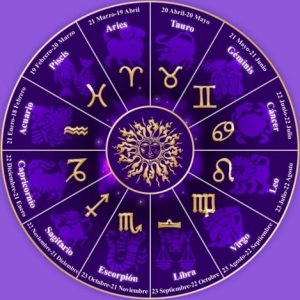 Doing your chart the old-fashioned way provides the best possible introduction to the science behind the art of astrology. But it’s a time-consuming process. Plus, if you make a mistake — and believe me, it’s easy to make a mistake — your efforts will be wasted. I know. When I first cast my own chart, I looked the results up in a book and was astonished to learn that I was the kind of extroverted person who rises to prominence in every group. Since, in reality, I was so shy that I sat in the back of every classroom and dreaded going to parties, I decided to try another book. This one opined that I was thin and bony, with a firm sense of self-discipline. If only.
Doing your chart the old-fashioned way provides the best possible introduction to the science behind the art of astrology. But it’s a time-consuming process. Plus, if you make a mistake — and believe me, it’s easy to make a mistake — your efforts will be wasted. I know. When I first cast my own chart, I looked the results up in a book and was astonished to learn that I was the kind of extroverted person who rises to prominence in every group. Since, in reality, I was so shy that I sat in the back of every classroom and dreaded going to parties, I decided to try another book. This one opined that I was thin and bony, with a firm sense of self-discipline. If only.
Either I was living someone else’s life or astrology was wrong. I decided to recalculate. That’s when I discovered that I had subtracted when I should have added. It was a small error on the page, but it made a substantial difference in the interpretation.
You don’t have to make a mistake like mine. By getting your chart on the Internet or by using astrological software — two options I discuss in Chapter 2 — you can be confident that the computations are accurate. And it only takes a moment.
But what if you’re outside the reach of a computer? What if you’re all alone on that mythical desert island, leaning against that palm tree, reading this article? Using only the information contained here, you can construct a rough version of your horoscope (or anyone else’s) — and for most purposes, that approximation will do just fine. First, copy the blank chart form on the Cheat Sheet, either by machine or — if that desert island doesn’t happen to have a Kinko’s — by hand. Next, follow the instructions in this chapter.
Using the Tables to Identify Your Planets
To figure out your planets, turn to the tables in the Appendix. For each planet, flip to the year of your birth and jot down its position, beginning with the luminaries:
- The Sun: Its position is your Sun sign — your sign of the zodiac.
If you were born on a day when the Sun moved from one sign to the next (that is, if you were born “on the cusp”), you need to take an extra step to identify your Sun sign, but you can only do it if you know the time of your birth. What you want to figure out is this: Which came first, your birth or the passage of the Sun into the next sign?
For instance, consider the horoscope of rocker Bruce Springsteen, born September 23, 1949. On that day, the Sun moved from analytical Virgo to Libra, the sign of relationships. Which one is he? The Sun made its move that day at 4:06 a.m. eastern standard time (EST). Bruce was born well after that, at 10:50 p.m. So he’s a Libra.
Making this calculation is more difficult if you were born in another time zone — but only slightly. The introductory material to the Appendix tells you how to account for time differences.
- The Moon: Figuring out the placement of the Moon, which represents your emotions, can be challenging because the Moon swings into a new sign of the zodiac every two or three days. Here too, the exact time of your birth can make a difference.
For instance, director Oliver Stone was born on September 15, 1946. Turn to the Moon Table in the Appendix. Since his birthday isn’t listed, check out the closest preceding day. You can see that on September 14 the Moon entered Taurus. It didn’t change signs until the 16th, when it entered Gemini. On the 15th, the Moon was still in the sign of the Bull. (And does Oliver Stone seem like a willful, emotional person who doesn’t let go easily and cares about money more than you might think? Makes sense to me.)
Identifying the Moon sign is more difficult in a case like that of actress Kate Hudson. She was born in Los Angeles on April 19, 1979, at 10:51 a.m. Pacific standard time (PST). On that day, according to the Moon Table in the Appendix, the Moon entered Aquarius at 15:02 (that is, 3:02 p.m.) eastern standard time. So is her Moon in Aquarius or is it in Capricorn?
To answer that, you need to figure out what time it was in California when the Moon changed sign. Since it’s three hours earlier on the West Coast, figuring out California time means subtracting three hours from EST. When it’s 3:02 p.m. in the East (or 15:02, as the table says), it’s 12:02 in L.A. That’s when the Moon slipped into Aquarius. Since Kate was born prior to that, at 10:51 a.m., her Moon is in Capricorn.
Of course, the Sun and the Moon aren’t the only celestial bodies that may have changed signs on the day you were born. On December 10, 1982, for example, Mercury, Mars, and the Moon all changed signs. If you were born on that eventful day, you would have to calculate the positions of all three. Or — as I suggest in Chapter 2 — you could skip the hard work and go directly to the Internet. But you should know: Those of us who learned how to cast horoscopes back when “Apple” was nothing more than a snack and a record label consider that a cheat.
What if you were born on a day when the Moon (or any other planet) changed sign but you don’t know the time of your birth? You have to guess. Read the descriptions of both signs to see whether one of them rings true. You may know immediately: One placement sounds just like you and the other sounds like no one you’ve ever even met. But don’t be surprised if it’s difficult to decide. First, every sign in the zodiac appears in your chart some-where, so some part of you identifies with every sign. Beyond that, other planets may blur the picture. For instance, the Moon may have moved from Taurus to Gemini on the day you were born. But if you also have Jupiter in Taurus and Venus in Gemini, you already have qualities associated with both signs, and it may be hard to isolate the effect of the Moon based solely on intuition. You need mathematics.
In most cases you can identify the signs occupied by the planets in your chart simply by looking them up in the Appendix, no calculation required. Just jot ’em down, using the following list:
- Mercury: The planet of communication has to be in one of three signs: Your Sun sign, the sign that precedes your Sun sign, or the sign that follows it. If Mercury is anywhere else, you’re reading the tables wrong.
- Venus: The planet of love and beauty is always within 48° of your Sun. So if your Sun is at 15° Gemini, your Venus could be as far away as 3° Leo or 12° Aries. Venus can never be farther than two signs away.
- The rest of the planets: They can be in any sign of the zodiac, regardless of your Sun sign.
Figuring Out Your Ascendant or Rising Sign
Figuring out the sign that was rising over the eastern horizon at the moment of your birth is the hardest part of casting a chart, but it’s essential because the Ascendant or rising sign represents the part of you that other people see (and sense) first.
Although figuring out the Ascendant isn’t for the faint-hearted, there’s a logic to it. At any given moment, one sign of the zodiac is rising in the east and its opposite sign is setting in the west. If you were born at dawn, when the Sun was on the horizon, your rising sign is the same as your Sun sign. If you have the Sun in Aries, you’re Aries rising — a double Aries, as they say, and a formidable example of fire signs in action. If you were born at sunset, your rising sign would be the opposite of your Sun sign: That is, if you’re an Aries born at dusk, you have Libra rising — and Aries setting.
The ecliptic — the path followed by the Sun as it moves across the sky (see Chapter 1) — surrounds the Earth like a gigantic ring. That ring is divided into 12 equal segments, one for each sign. As the Earth rotates on its axis, it spins past each segment — all 12 signs in 24 hours, or approximately one sign every two hours (although latitude makes a difference and some signs hang around longer than others). The segment of the zodiac that happens to be coming up over the horizon at the moment of your birth is your rising sign.
Finding Your Rising Sign In Three Easy Steps
Here’s how to figure out your rising sign the easy way:
- Turn to Figure 3-1.
- Locate your birth time in the boldface horizontal row at the top of the table or in the boldface horizontal row in the middle of the table.
- Find your Sun sign in the column on the left side of the table.
The point where the horizontal row and the vertical column intersect shows your probable rising sign.
Don’t forget daylight saving time, which has usually been in operation in the United States from the last Sunday in April to the last Sunday in October. You can account for it by subtracting one hour from your birth time.
As an example of how this table works, consider the actress Nicole Kidman, a Gemini born June 20, 1967, at 3:15 p.m. in Honolulu, Hawaii (although, yes, she grew up in Australia). Find her Sun sign (Gemini) in the column on the left. Now run your finger across the Gemini row until you reach the column labeled “2 p.m. – 4 p.m.” The sign that appears there — Scorpio — is her rising sign or Ascendant. Precise calculations bear that out. (Note that although Nicole was born between April and October, it isn’t necessary to make an adjustment for daylight saving time because it isn’t observed in Hawaii.)
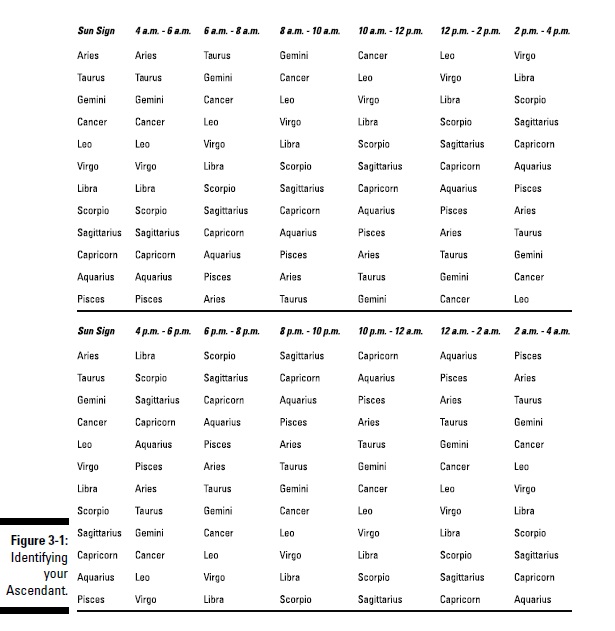
Figure 3-1: Identifying Your Ascendant.
Does that Scorpio Ascendant make sense? To my mind, it describes perfectly her intense, mysterious appeal. Think of To Die For, her break-out movie, in which she plays an upbeat Gemini-like weather girl with a dark, seductive, manipulative — dare I say Scorpionic? — bent. Despite her sunny beauty and high-profile status as a fashion icon, there’s something enigmatic and opaque about Nicole. Who is she, really? I mean, has anyone out there seen Dogville?
Beware Of The Limitations
Although this method for estimating the rising sign works for Nicole Kidman, it’s by no means a perfect technique. Often, precise calculations don’t square with the results of the table. One reason is that the Earth revolves around the Sun at a tilt. As a result, some signs (like Gemini) take longer to rise over the horizon than others (like Pisces). So the two-hour blocks I divided the day into are artificially equal.
Geography also matters. Imagine two babies born in New England on January 1, 2001, at 11 a.m. The one born in Portland, Maine, has Aries rising, as predicted by the table. But the Earth is curved, and a few hundred miles away, in Hartford, Connecticut, Aries has yet to climb over the horizon. The child born there has Pisces rising. I hate to admit it, but the table will not reflect that difference.
So when you use this table, know that it can’t be fully trusted. More than half the time, it’s right on the money. The rest of the time, it’s wrong, generally by one sign. If the sign given as your Ascendant doesn’t sound right to you, contemplate the signs on either side (with particular attention to the sign that comes first). For example, if the table says you’re Gemini rising, but in real life you’re the strong, silent type, consider the possibility that Gemini may not be your Ascendant, and read Taurus instead.
Determining Your Houses
Once you have identified your rising sign, your troubles are over. If you haven’t already done so, go to the Cheat Sheet and make a copy of the blank chart. (Or draw a circle and divide it into 12 pie-shaped pieces, representing the houses.) Now all you have to do is label the houses with the appropriate signs.
Begin by labeling the first house with the name (or better yet, the symbol) of your rising sign. Then move counterclockwise around the circle, labeling the second house with the sign that follows your rising sign, the third house with the sign that follows that, and so on. No matter what your rising sign is, the signs always follow in their usual order: That is, they begin with Aries and proceed to Pisces, going counterclockwise. (See the Cheat Sheet.) Thus, if you have Aries rising, then Taurus is on the cusp of the second house, Gemini on the cusp of the third, and so on to the twelfth house, where Pisces presides. And if you’re Scorpio rising, you have Sagittarius on the cusp of the second house, Capricorn on the cusp of the third, and so on, right up to Libra, which is the sign on the cusp of the twelfth house. In that case, the wheel of your chart should look something like Figure 3-2.
Dividing The Houses
Astrologers have long debated the best way of slicing up a chart. The most common approaches are the Koch system, a time-based method introduced in 1962, and the Placidus system, an equally complex technique named after Placidus de Tito, a 17th-century astrologer who got it from an Arabian astrologer of the 8th century. Placidus is difficult to calculate and grossly inaccurate in northern latitudes. Nonetheless, because it’s widespread, it’s the system I use for the charts in this article.
The simplest system — well, actually the second simplest — was invented by Ptolemy almost 2,000 years ago. It’s called the equal house system because it assumes that all the houses are the same size. In this system, if your Ascendant is 12°26′ Leo (like Johnny Depp’s), you have 12°26′ Virgo on the cusp of the second house, 12°26′ Libra on the cusp of the third, and so on around the chart.
The most straightforward system of house division comes from Hindu astrology. It aligns the houses with the signs and puts 0 degrees on the cusp of every house. (The Ascendant is, therefore, not the cusp of the first house but simply a point within it.) So if you have Sagittarius rising, all of Sagittarius is in your first house, all of Capricorn in your second house, and so on. In this chapter, I recommend this method. Although this system isn’t used extensively in Western astrology, the astrologer Robert Hand recommends its revival — and there’s much to be said for it, especially when you suspect that the birth time is incorrect. If that’s your situation, I recommend this system. Put your Sun sign on the cusp of the first house (at nine o’clock) and continue from there.
The first house begins at nine o’clock and extends counterclockwise to eight o’clock, the second house begins at eight o’clock and goes to seven o’clock, and so on.
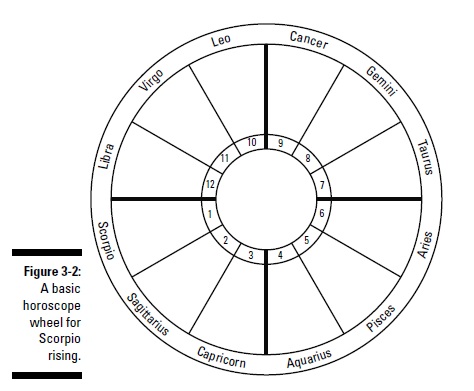
Figure 3-2 A basic Horoscope Wheel For Scorpio Rising
Creating a Horoscope
Putting together a basic birth chart involves these steps: Looking up the planets, figuring out your Ascendant, making the wheel of the horoscope, and placing the planets on the wheel. After that, you’re ready for the true art of astrology: interpretation.
To illustrate the process, let’s go back to Nicole Kidman, who was born on June 20, 1967, at 3:15 p.m. in Honolulu. To make her birth chart, begin by looking up her planets in the Appendix. Here’s what we find for that day:
Her Sun is in Gemini. Her Moon is in Sagittarius.
The North Node of the Moon is in Taurus (which means that the South Node is in Scorpio).
Mercury is in Cancer.
Venus is in Leo.
Mars is in Libra.
Jupiter is in Leo.
Saturn is in Aries.
Uranus is in Virgo.
Neptune is in Scorpio.
Pluto is in Virgo.
The next step is to figure out her rising sign, which we did earlier in the chapter. It’s Scorpio.
Now take a blank horoscope wheel like the one on the Cheat Sheet and assign Scorpio to the first house, Sagittarius to the second, and so on, as shown in Figure 3-2. Write the symbols for the planets (or their names) in the correct houses. If you’re a beginner, you may want to do this in plain English, a process that yields a chart that looks something like Figure 3-3.
Better yet, memorize the beautiful and mysterious astrological symbols. That way, you end up with a chart that looks like Figure 3-4.
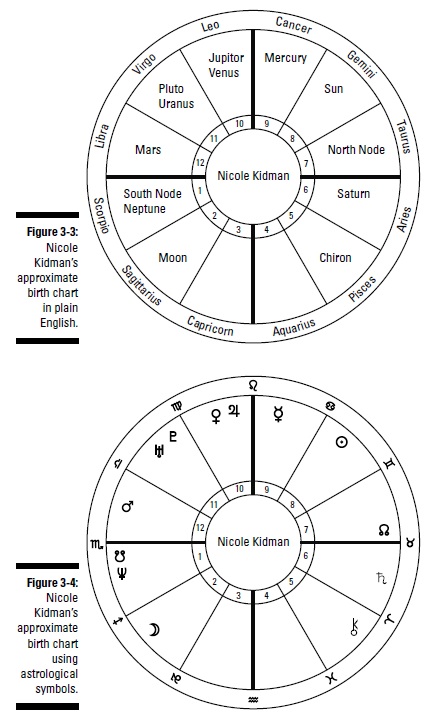
Figure 3. 4
Of course, the best possible chart is more specific. If you get your chart from the Internet or generate it yourself using astrological software, you’ll get something like Figure 3-5. This figure shows Nicole’s horoscope, adjusted for place (Honolulu) and calculated to the minute via computer, using the Placidus system of house division (see the sidebar “Dividing the houses” for more on this system).
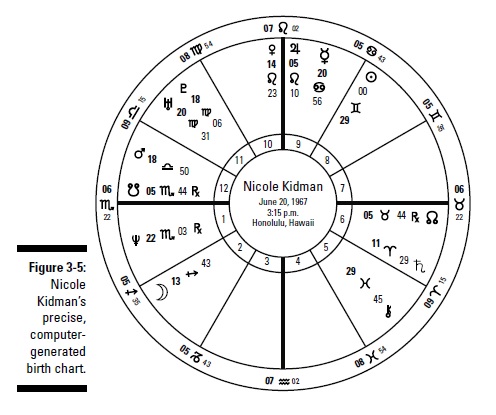
Figure 3-5: Nicole Kidman’s precise, computer-generated birth chart.
Are there differences between these methods? There are, though in Nicole’s case, the differences aren’t dramatic. The main difference is that an exact chart provides specific degrees for the planets, the Ascendant, and the house cusps. That information is crucial, especially for timing predictions. Nonetheless, an estimated chart is still stuffed with information about your personality, your talents, your weaknesses, your desires, your love life, your career, and even your future. It’s not perfect. But it’s thought-provoking and absorbing, and a good place to start.
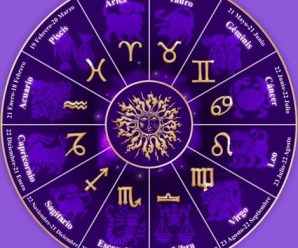
Leave a Reply